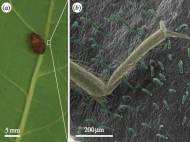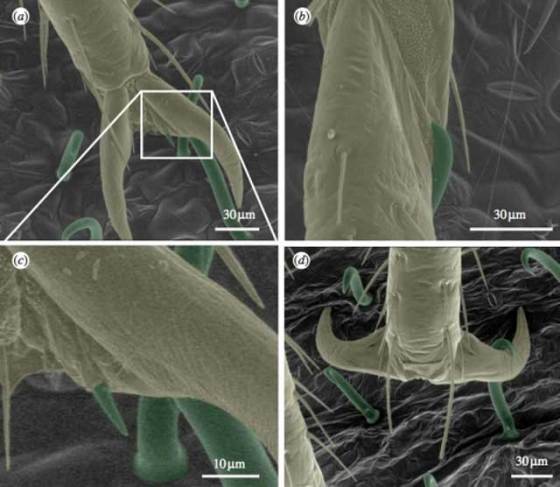Mimicking bean leaves ability to trap bedbugs on the way
 Inspired by a traditional Balkan bedbug remedy, researchers at UC Irvine and the University of Kentucky have documented how microscopic hairs on kidney bean leaves effectively stab and trap these biting insects. The researchers are going to use these findings to develop materials that mimic the geometry of the leaves in order to aid in fight against the pest.
Inspired by a traditional Balkan bedbug remedy, researchers at UC Irvine and the University of Kentucky have documented how microscopic hairs on kidney bean leaves effectively stab and trap these biting insects. The researchers are going to use these findings to develop materials that mimic the geometry of the leaves in order to aid in fight against the pest.
Bedbugs have made a dramatic comeback in the U.S. in recent years, infesting everything from homes and hotels to schools, movie theaters and hospitals. These nocturnal parasites can survive as long as a year without a blood meal, and they often migrate from place to place. Although not known to transmit disease, their bites can cause burning, itching, swelling and psychological distress.
Current commercial prevention methods, including freezing, extreme heating, vacuuming and pesticides, can be costly and unreliable. Many sufferers resort to ineffective, potentially dangerous measures, such as spraying non-approved insecticides themselves rather than hiring a professional. Centuries-old remedy for bedbugs used in Bulgaria, Serbia and other southeast European countries relies on structure of Kidney bean leaves.
Once strewn on the floor next to beds, Kidney bean leaves trap the blood-seeking parasites on their nightly forays. The bug-encrusted greenery was burned the next morning to exterminate the insects. The researchers investigated this phenomenon and discovered that the creatures are trapped within seconds of stepping on a leaf, their legs impaled by microscopic hooked hairs known botanically as trichomes.
Doctoral student Megan Szyndler, entomologist Catherine Loudon and chemist Robert Corn of UC Irvine and entomologists Kenneth Haynes and Michael Potter of the University of Kentucky collaborated on the new study.
The researchers have microfabricated materials that closely resemble bean leaves. The synthetic surfaces snag the bedbugs temporarily but do not yet stop them as effectively as real leaves. The researchers believe that crucial mechanics of the trichomes still need to be determined before these templates become more efficient.
Theoretically, bean leaves could be used for pest control, but they dry out and don’t last very long. They also can’t easily be applied to locations other than a floor. Synthetic materials could provide a nontoxic alternative that can be placed on vertical surfaces.
“Nature is a hard act to follow, but the benefits could be enormous”, said Potter. “Imagine if every bedbug inadvertently brought into a dwelling was captured before it had a chance to bite and multiply.”










Leave your response!